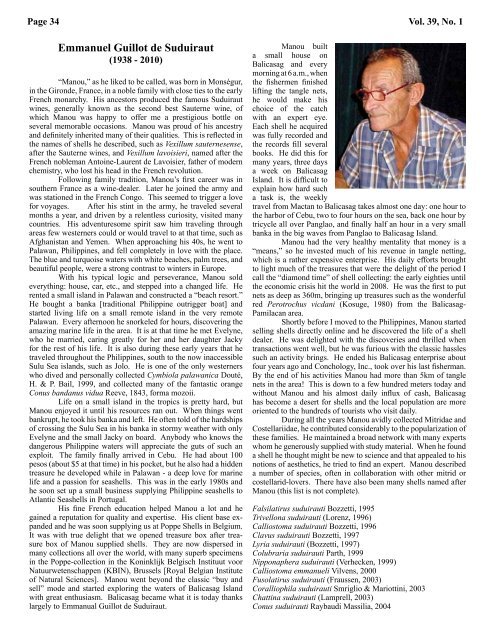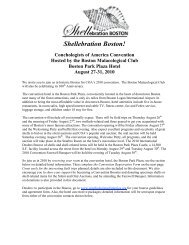download PDF - Conchologists of America
download PDF - Conchologists of America
download PDF - Conchologists of America
Create successful ePaper yourself
Turn your PDF publications into a flip-book with our unique Google optimized e-Paper software.
Page 34 Vol. 39, No. 1<br />
Emmanuel Guillot de Suduiraut<br />
(1938 - 2010)<br />
“Manou,” as he liked to be called, was born in Monségur,<br />
in the Gironde, France, in a noble family with close ties to the early<br />
French monarchy. His ancestors produced the famous Suduiraut<br />
wines, generally known as the second best Sauterne wine, <strong>of</strong><br />
which Manou was happy to <strong>of</strong>fer me a prestigious bottle on<br />
several memorable occasions. Manou was proud <strong>of</strong> his ancestry<br />
and definitely inherited many <strong>of</strong> their qualities. This is reflected in<br />
the names <strong>of</strong> shells he described, such as Vexillum sauternesense,<br />
after the Sauterne wines, and Vexillum lavoisieri, named after the<br />
French nobleman Antoine-Laurent de Lavoisier, father <strong>of</strong> modern<br />
chemistry, who lost his head in the French revolution.<br />
Following family tradition, Manou’s first career was in<br />
southern France as a wine-dealer. Later he joined the army and<br />
was stationed in the French Congo. This seemed to trigger a love<br />
for voyages. After his stint in the army, he traveled several<br />
months a year, and driven by a relentless curiosity, visited many<br />
countries. His adventuresome spirit saw him traveling through<br />
areas few westerners could or would travel to at that time, such as<br />
Afghanistan and Yemen. When approaching his 40s, he went to<br />
Palawan, Philippines, and fell completely in love with the place.<br />
The blue and turquoise waters with white beaches, palm trees, and<br />
beautiful people, were a strong contrast to winters in Europe.<br />
With his typical logic and perseverance, Manou sold<br />
everything: house, car, etc., and stepped into a changed life. He<br />
rented a small island in Palawan and constructed a “beach resort.”<br />
He bought a banka [traditional Philippine outrigger boat] and<br />
started living life on a small remote island in the very remote<br />
Palawan. Every afternoon he snorkeled for hours, discovering the<br />
amazing marine life in the area. It is at that time he met Evelyne,<br />
who he married, caring greatly for her and her daughter Jacky<br />
for the rest <strong>of</strong> his life. It is also during these early years that he<br />
traveled throughout the Philippines, south to the now inaccessible<br />
Sulu Sea islands, such as Jolo. He is one <strong>of</strong> the only westerners<br />
who dived and personally collected Cymbiola palawanica Douté,<br />
H. & P. Bail, 1999, and collected many <strong>of</strong> the fantastic orange<br />
Conus bandanus vidua Reeve, 1843, forma mozoii.<br />
Life on a small island in the tropics is pretty hard, but<br />
Manou enjoyed it until his resources ran out. When things went<br />
bankrupt, he took his banka and left. He <strong>of</strong>ten told <strong>of</strong> the hardships<br />
<strong>of</strong> crossing the Sulu Sea in his banka in stormy weather with only<br />
Evelyne and the small Jacky on board. Anybody who knows the<br />
dangerous Philippine waters will appreciate the guts <strong>of</strong> such an<br />
exploit. The family finally arrived in Cebu. He had about 100<br />
pesos (about $5 at that time) in his pocket, but he also had a hidden<br />
treasure he developed while in Palawan - a deep love for marine<br />
life and a passion for seashells. This was in the early 1980s and<br />
he soon set up a small business supplying Philippine seashells to<br />
Atlantic Seashells in Portugal.<br />
His fine French education helped Manou a lot and he<br />
gained a reputation for quality and expertise. His client base expanded<br />
and he was soon supplying us at Poppe Shells in Belgium.<br />
It was with true delight that we opened treasure box after treasure<br />
box <strong>of</strong> Manou supplied shells. They are now dispersed in<br />
many collections all over the world, with many superb specimens<br />
in the Poppe-collection in the Koninklijk Belgisch Instituut voor<br />
Natuurwetenschappen (KBIN), Brussels [Royal Belgian Institute<br />
<strong>of</strong> Natural Sciences]. Manou went beyond the classic “buy and<br />
sell” mode and started exploring the waters <strong>of</strong> Balicasag Island<br />
with great enthusiasm. Balicasag became what it is today thanks<br />
largely to Emmanual Guillot de Suduiraut.<br />
Manou built<br />
a small house on<br />
Balicasag and every<br />
morning at 6 a.m., when<br />
the fishermen finished<br />
lifting the tangle nets,<br />
he would make his<br />
choice <strong>of</strong> the catch<br />
with an expert eye.<br />
Each shell he acquired<br />
was fully recorded and<br />
the records fill several<br />
books. He did this for<br />
many years, three days<br />
a week on Balicasag<br />
Island. It is difficult to<br />
explain how hard such<br />
a task is, the weekly<br />
travel from Mactan to Balicasag takes almost one day: one hour to<br />
the harbor <strong>of</strong> Cebu, two to four hours on the sea, back one hour by<br />
tricycle all over Panglao, and finally half an hour in a very small<br />
banka in the big waves from Panglao to Balicasag Island.<br />
Manou had the very healthy mentality that money is a<br />
“means,” so he invested much <strong>of</strong> his revenue in tangle netting,<br />
which is a rather expensive enterprise. His daily efforts brought<br />
to light much <strong>of</strong> the treasures that were the delight <strong>of</strong> the period I<br />
call the “diamond time” <strong>of</strong> shell collecting: the early eighties until<br />
the economic crisis hit the world in 2008. He was the first to put<br />
nets as deep as 360m, bringing up treasures such as the wonderful<br />
red Perotrochus vicdani (Kosuge, 1980) from the Balicasag-<br />
Pamilacan area.<br />
Shortly before I moved to the Philippines, Manou started<br />
selling shells directly online and he discovered the life <strong>of</strong> a shell<br />
dealer. He was delighted with the discoveries and thrilled when<br />
transactions went well, but he was furious with the classic hassles<br />
such an activity brings. He ended his Balicasag enterprise about<br />
four years ago and Conchology, Inc., took over his last fisherman.<br />
By the end <strong>of</strong> his activities Manou had more than 5km <strong>of</strong> tangle<br />
nets in the area! This is down to a few hundred meters today and<br />
without Manou and his almost daily influx <strong>of</strong> cash, Balicasag<br />
has become a desert for shells and the local population are more<br />
oriented to the hundreds <strong>of</strong> tourists who visit daily.<br />
During all the years Manou avidly collected Mitridae and<br />
Costellariidae, he contributed considerably to the popularization <strong>of</strong><br />
these families. He maintained a broad network with many experts<br />
whom he generously supplied with study material. When he found<br />
a shell he thought might be new to science and that appealed to his<br />
notions <strong>of</strong> aesthetics, he tried to find an expert. Manou described<br />
a number <strong>of</strong> species, <strong>of</strong>ten in collaboration with other mitrid or<br />
costellarid-lovers. There have also been many shells named after<br />
Manou (this list is not complete).<br />
Falsilatirus suduirauti Bozzetti, 1995<br />
Trivellona suduirauti (Lorenz, 1996)<br />
Calliostoma suduirauti Bozzetti, 1996<br />
Clavus suduirauti Bozzetti, 1997<br />
Lyria suduirauti (Bozzetti, 1997)<br />
Colubraria suduirauti Parth, 1999<br />
Nipponaphera suduirauti (Verhecken, 1999)<br />
Calliostoma emmanueli Vilvens, 2000<br />
Fusolatirus suduirauti (Fraussen, 2003)<br />
Coralliophila suduirauti Smriglio & Mariottini, 2003<br />
Chattina suduirauti (Lamprell, 2003)<br />
Conus suduirauti Raybaudi Massilia, 2004




